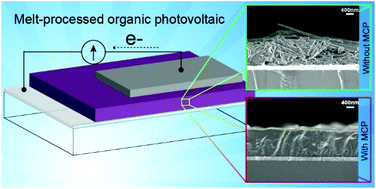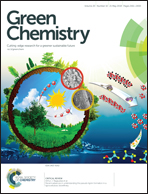Melt-processing of small molecule organic photovoltaics via bulk heterojunction compatibilization†
Abstract
Melt-processing of organic semiconductors (OSCs) is a promising environmentally-friendly technique that can alleviate dependence on toxic chlorinated solvents. While melt-processed single-component OSC devices (e.g. field-effect-transistors) have been demonstrated, multi-component bulk heterojunctions (BHJs) for organic photovoltaics (OPVs) remain a challenge. Herein, we demonstrate a strategy that affords tunable BHJ phase segregation and domain sizes from a single-phase homogeneous melt by employing strongly-crystalline small-molecule OSCs together with a customized molecular compatibilizing (MCP) additive. An optimized photoactive BHJ with 50 wt% MCP achieved a device power conversion efficiency of ca. 1% after melting the active layer at 240 °C (15 min, followed by slow cooling) before deposition of the top electrode. BHJ morphology characterization using atomic force and Kelvin probe microscopy, X-ray diffraction, and photo-luminescence measurements further demonstrate the trade-off between free charge generation and transport with respect to MCP loading in the BHJ. In addition, a functional OPV was also obtained from the melt-processing of dispersed micron-sized solid BHJ particles into a smooth and homogeneous thin-film by using the MCP approach. These results demonstrate that molecular compatibilization is a key prerequisite for further developments towards true solvent-free melt-processed BHJ OPV systems.



 Please wait while we load your content...
Please wait while we load your content...